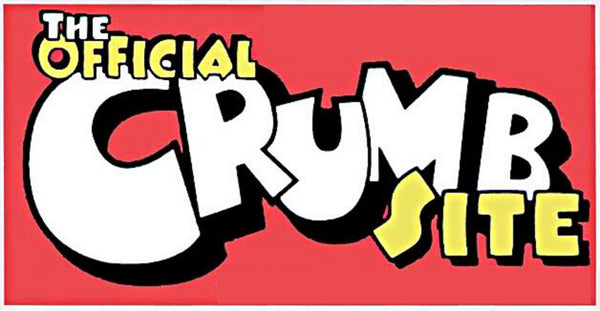Biography
Early Family Life
This biography was written by Alexander Wood and was edited by Robert Crumb. All artwork is © Robert Crumb.
Robert Crumb was born in Philadelphia on Aug. 30, 1943, to a Marine father and a Catholic mother. His family frequently moved during his childhood and moved to Delaware in 1956 when his father retired after twenty years in the U.S. Marine Corps. Robert’s mother often behaved erratically and was probably manic-depressive. Robert was a faithful Catholic until he was sixteen. His biggest influence during his youth was his older brother Charles, who loved comics and co-wrote many of the comics they produced as children. Crumb was anything but popular in high school and felt alienated. “I was one of those social rejects, but then, you know, many people were — nothing unusual about being an outcast in high school.”
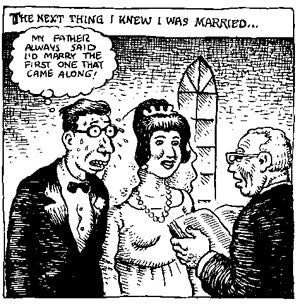
Illustrator
After graduating from high school, Robert spent a depressing year at home, mostly drawing, and talking endlessly about the meaning of life with Charles, who never did leave home. He finally left for Cleveland in 1962 to live with his friend Marty Pahls, and soon found work with the American Greetings Corporation as a color separator. He was promoted within a year to the Hi-Brow Department and drew hundreds of cards over the next several years. His job as a commercial illustrator would have an effect on his future work. My boss kept telling me my drawings were too grotesque. I was trained to draw 'cute' little neuter characters which influenced my technique, and even now my work has this cuteness about it.
In 1964, Crumb lost his virginity to Dana Morgan, who he married later in the year. They honeymooned in Europe for six months, while Crumb continued to mail in his illustrations for American Greetings.
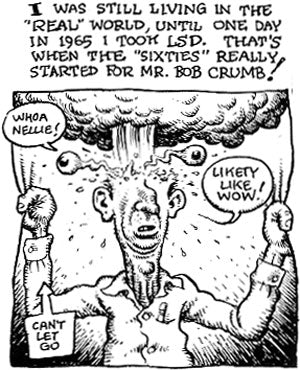
Acid
"I started taking L.S.D. in Cleveland in June of ’65. That changed my head around. It made me stop taking cartooning so seriously and showed me a whole other side of myself.”
After a temporary breakup with Dana, Robert traveled to New York, Chicago, and Detroit during this acid-soaked period and created many of his future characters: Mr. Natural, Mr. Snoid, and Angelfood McSpade.

San Fransisco
In January 1967, Crumb suddenly left Cleveland. “I escaped to San Francisco when I met two guys in a bar who said they were driving west.” Dana followed him there, and they eventually settled in Haight-Ashbury. Crumb drew “Zap #1” and “Zap #0” in the fall of 1967 and sold them on the street in 1968 (out of Jesse’s baby carriage). So marks the birth of underground comics with Crumb as its most recognizable force. His son Jesse was born at this time, in April 1968.
Robert continued to draw and travel throughout the rest of the decade.
“I was all over the map in ’69. I didn’t spend much time at home. I was chasing women all over the place. I lived for a while in a hotel on Mission Street. That’s where ‘Big Ass’ and ‘Snatch 3’ were done. I was so mixed up. I stayed a couple of months with Gilbert Shelton and a gang of Texans in Venice, California. I was in Detroit, Chicago, and New York. It’s amazing I managed to turn out so much work in that chaotic time.”
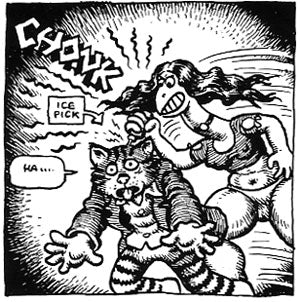
Fritz the Cat
In the last months of 1969, Crumb received a $10,000 advance from Ballantine Books for a “Fritz the Cat” book. He used that money as a down payment on a plot of land north of San Francisco in Potter Valley where he, Dana, and baby Jesse moved. In 1970, Crumb began a five-year, on-again-off-again relationship with Kathy Goodell, who lived in San Francisco. In the same year, Crumb’s wife gave permission for Ralph Bakshi to use Fritz the Cat in a full-length feature film. Crumb, entirely dissatisfied with the project, soon after killed Fritz the Cat, a character he had created in adolescence.

The 70s
In the first few years of the decade, Crumb continued to traverse the country and draw. But by 1974, Crumb moved from what had become a commune in Potter Valley and settled down in Madison, California with his new girlfriend, Aline Kominsky (later to become his second wife). He stopped smoking marijuana at that time. He drew a “Mr. Natural” strip which ran in “The Village Voice” for about a year (later compiled as “Mr. Natural #3”). He also started playing banjo and mandolin in the Cheap Suit Serenaders Band, which usually performed in the Bay area.
His revolutionary character Frosty the Snowman (Arcade comics in the mid-seventies) may have brought the wrong sort of attention from the government because by 1977 Crumb was embroiled in a legal battle with the IRS.
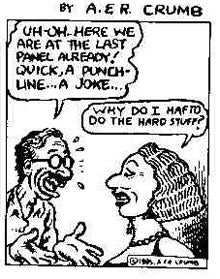
The Weirdo Years
In 1981, Crumb produced and edited a new comic magazine called “Weirdo” which included the work of other artists. Aline’s and Robert’s daughter Sophie was born at this time. In the mid-eighties, Robert decided to let Peter Bagge (and eventually Aline) take over the job as editor of Weirdo so that he could spend more time doing his own comics. While still contributing to “Weirdo,” he created the “Hup 1-4” series in the late 1980s and early 90's.
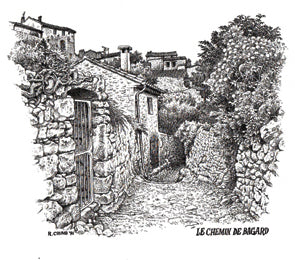
France
By the end of the 1980s, with suburban sprawl increasing, the Crumbs became disgusted with America and, at Aline's instigation, decided to leave. Robert exchanged some of his sketchbooks for their new house in the south of France. Crumb’s friend, Terry Zwigoff, filmed Robert and his family before they moved and the resulting documentary “Crumb” achieved some success at the box office in America and some countries in Europe.

Present Day
Except for the occasional expedition to Paris or America, Crumb has nestled himself in the south of France. He finished his long-term project illustrating the book of Genesis which has now been published. He owns almost five thousand 78 RPM records in his collection. Aline is pursuing her interests in comics, painting, and sculpting.
